The real laboratory was on the mountainsides where things happened in the forest “test tubes.” But a lot of recording, record-keeping, and glass test-tube testing had to be done where it was warm and dry, inside Pleasant View.
Fancy measuring equipment hummed in the enclosed back porch. Shiny glass tubes, Petri dishes, and microscope slides glistened. A Bunsen burner burned a bright-orange flame that boiled water. The water changed into water vapor, wound through circles of plastic tubing, condensed, and dripped into a glass bottle – distilled. Distilled water was needed for experiments.
Penny, one of Dr. Likens’ students, sat in front of two tall glass tubes. Her waist-long honey-colored hair was tied back in a ponytail. Dressed in blue jeans and a loose, wrinkled, faded blue cotton shirt, she hunched over a ledger recording columns of numbers. There was just enough room to walk behind her and watch.
She was titrating water from Mirror Lake. Two long glass tubes hung down from a tall T-shaped holder. Beakers of muddy water caught drips of water from the pointed tip of one tube. Penny turned a screw near the pointed tip. One by one drips of clear liquid fell into the muddy water. Nothing happened. At last one drip seemed to change the color of the water in the beaker from light brown to clear. A few drops of clear water couldn’t possibly make that brown water so clean and clear. But the drops were a chemical, not plain water. And it wasn’t ordinary muddy water. This water was part of the water samples taken from Mirror Lake. Trying to discover the amount of oxygen produced by the lake’s microscopic green plants, or phytoplankton, Penny had put chemicals in the lake samples when she had collected them. The chemicals turned the samples brown. Indoors she counted and recorded the number of drips of another chemical from the glass tube. This chemical made the water clear again. The number of drips needed to make the brown water clear told her how much oxygen was in her water sample.
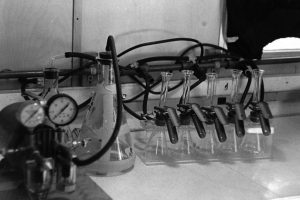
Penny had been a chemistry major during her first four years of college. Now, for her master’s degree, she was majoring in ecology at Cornell University.
Although Penny’s job didn’t look very exciting, Penny knew what she was doing and why she was doing it. She rather liked working by herself and making neat pages of numbers. Even if she didn’t get to use the data herself, someone else could use her data. Her work might help someone understand our world better.
In the future, if scientists wanted to know whether the oxygen produced in the lake was increasing or decreasing, they couldn’t tell unless they had earlier records, a base line, to compare to their data. Researchers could do the same thing Penny had done and then compare their results with Penny’s and discover what had happened to the lake. Most of the researchers at Pleasant View had to do some tedious and monotonous things – plain old hard work. Penny straightened her shoulders, tossed her ponytail onto her back, and sighed, relaxing.
Research isn’t always the excitement that television and movies squeeze into an hour. Of course it has thrilling moments, but those usually come after years of routine and lots of trial and error. New methods, techniques, and experiments for gathering data are tried, repeated, or eliminated. You usually hear only about the successes. But you must be comfortable with trials and errors too. If you discourage easily, you won’t like research.
Dave G’s setup in the basement was a laboratory that looked like something from a Frankenstein show. Frequently Dave disappeared down the stairs under the floor in the dining room. A section of floor could be raised with a large ring. Hinges squeaked. Down the dark, cool stairwell, steps led to the old basement with walls of carefully fitted stones. A modernized furnace stood along one wall. A third of the basement shone with an eerie light. Large heavy plastic sheets created a wall around test tubes and large beakers of bubbling water. This improvised lab was the source of the light.
Dave busily recorded data. His experiments had to be kept at 70 degrees. It often got colder than that in New Hampshire, even in the summer. The constant lights took the place of sunlight. In this lab, water from nearby Mirror Lake was tested. Dave added different chemicals to lake samples to see in which water the phytoplankton grew best. He did the same thing with different columns of water in the lake itself, his outdoor laboratory. He added one chemical to one column of water, a second chemical to a second column, a third chemical to a third column, and so on, then periodically checked plant growth in each column. The indoor lab work was a duplication of this outdoor lake work. In this way he checked his lake water figures with a closely controlled experimental situation.
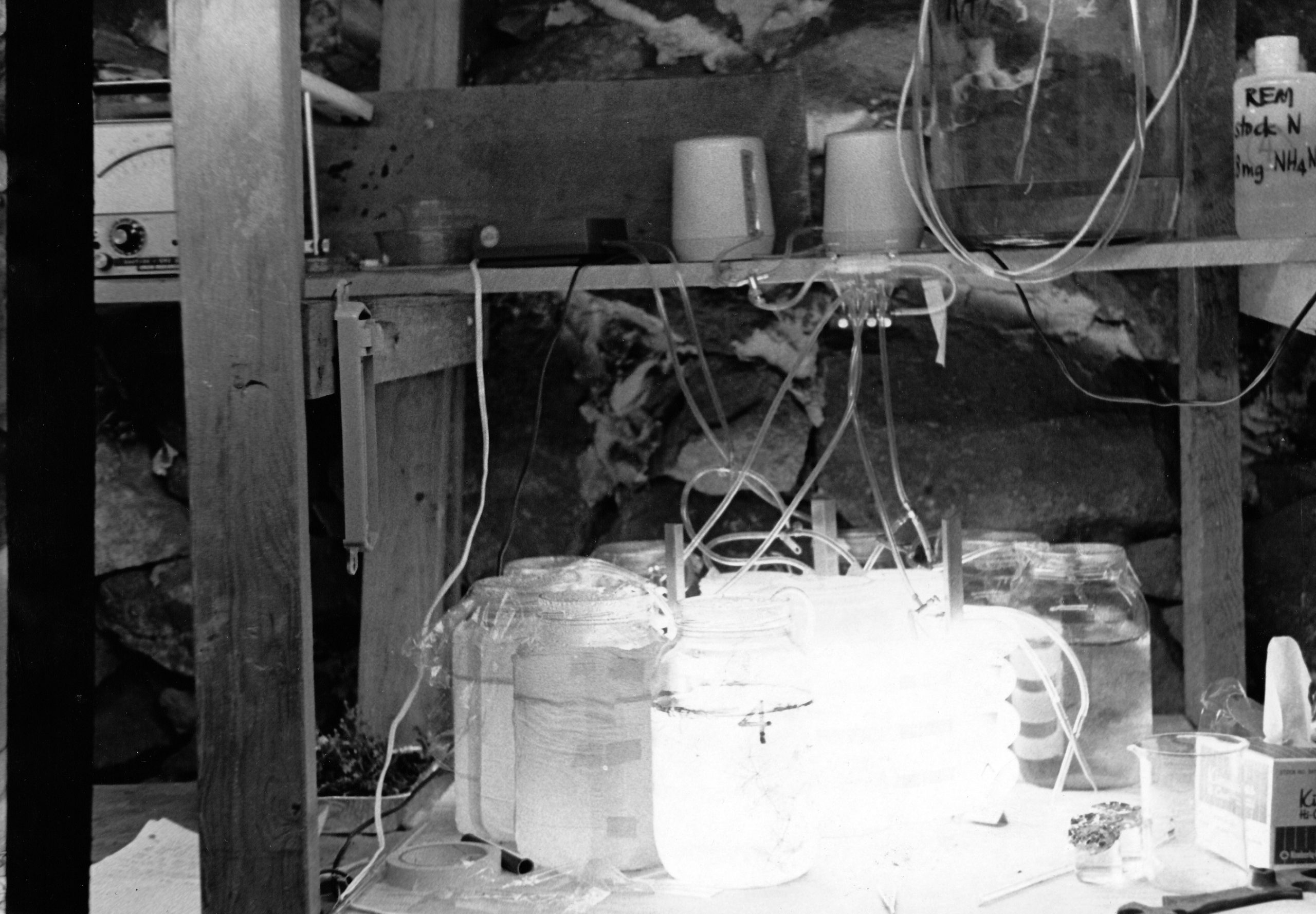
Phytoplankton was the main food source for the primary consumer animals in the lake. It was the beginning of a long food chain for many, many animals, terrestrial as well as aquatic. This tiny little plant indirectly nourished fish-eating bears and humans too.
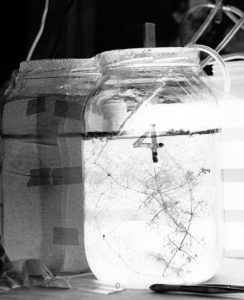
Having climbed out of the cellar, Dave might close the trapdoor behind him and walk silently through the back dining room so as not to interrupt the counting of zooplankton, the microscopic animals that live in the lake and feed on phytoplankton. These are primary consumers that become prey for secondary consumers farther along the lake’s food chain. Joe, a graduate student of Dr. Likens, spent many hours with his eye glued to a powerful compound microscope that made everything look a hundred times larger. He counted the number of zooplankton in each drop of water on his slide. He counted slide after slide of zooplankton from a fixed amount of lake water. With the help of a mathematical formula that allowed for error, he determined about how many of the tiny little animals were in the lake. If he lost count or was interrupted before he finished a slide, he had to start all over again.
Of these tiny animals that ate plants and floated in the water, over 120 had been identified. The phytoplankton and zooplankton studies were important because these plants and animals were the basic food for the crayfish and the fish in the lake.
In the wintertime Joe made special trips to get lake water and zooplankton samples. He cut a circle in the ice and took his sample from the water beneath. Back at Pleasant View the warmth from the kitchen trash burner always felt very good after such a cold outing.
Joe would not look up as Dave walked down the hall to the front door and joined Dr. Likens and Penny on the porch.
Penny was putting black tape around pint bottles. Every inch of glass was being covered by black tape. Dr. Likens helped her.
The dark bottles helped Penny discover the amount of oxygen the phytoplankton produced. Light passed through the clear glass bottles into the water, but light couldn’t get into the dark bottles. Photosynthesis, which needs light, gives off oxygen. In the dark bottles without light, there could be no photosynthesis and no oxygen by-product.
Plants and animals use oxygen to break down their food in a process called respiration. Plants don’t just release oxygen; they also use some of what they release.
Penny tried to find out how much oxygen was left over and added to the lake after plants used what they needed. The amount of oxygen was the same in each bottle at the start and the plants in each bottle used the same amount of oxygen. The only difference between the bottles would be the oxygen released by the plants in the clear bottle.
Penny measured the oxygen in both bottles by a chemical method she used in the lab. She subtracted the black-bottle measurement (B) from the clear-bottle measurement (C): C-B=O2, or oxygen added to the lake. The more samples she took, the more numbers she had to average, and the closer her guess came to the real amount of oxygen the phytoplankton added to the lake.
Placing each bottle in its own section of a divided box, Penny moved her empty clear and dark bottles to the back seat of her small bug of a car. Then she roared down the lane to the Mirror Lake road. She made many trips at regular intervals day and night to place new bottles in the lake and bring back stoppered bottles for oxygen counts. In the quiet of the night and early-morning hours light sleepers heard her car and knew Penny was conscientiously doing her job.
One day Penny’s Volkswagen had just dipped below the rise in the drive when Dave G. pulled a strange-looking monster from the garage.
Out on the lawn in front of the house Dave shook out three circular rings, like hoops in an old-fashioned skirt. A satiny nylon fabric covered the hoops, joining them together in one long cylinder. Sheryl offered to help hold one end up and looked through the wide tunnel to see Dave at the other end about nine feet away.
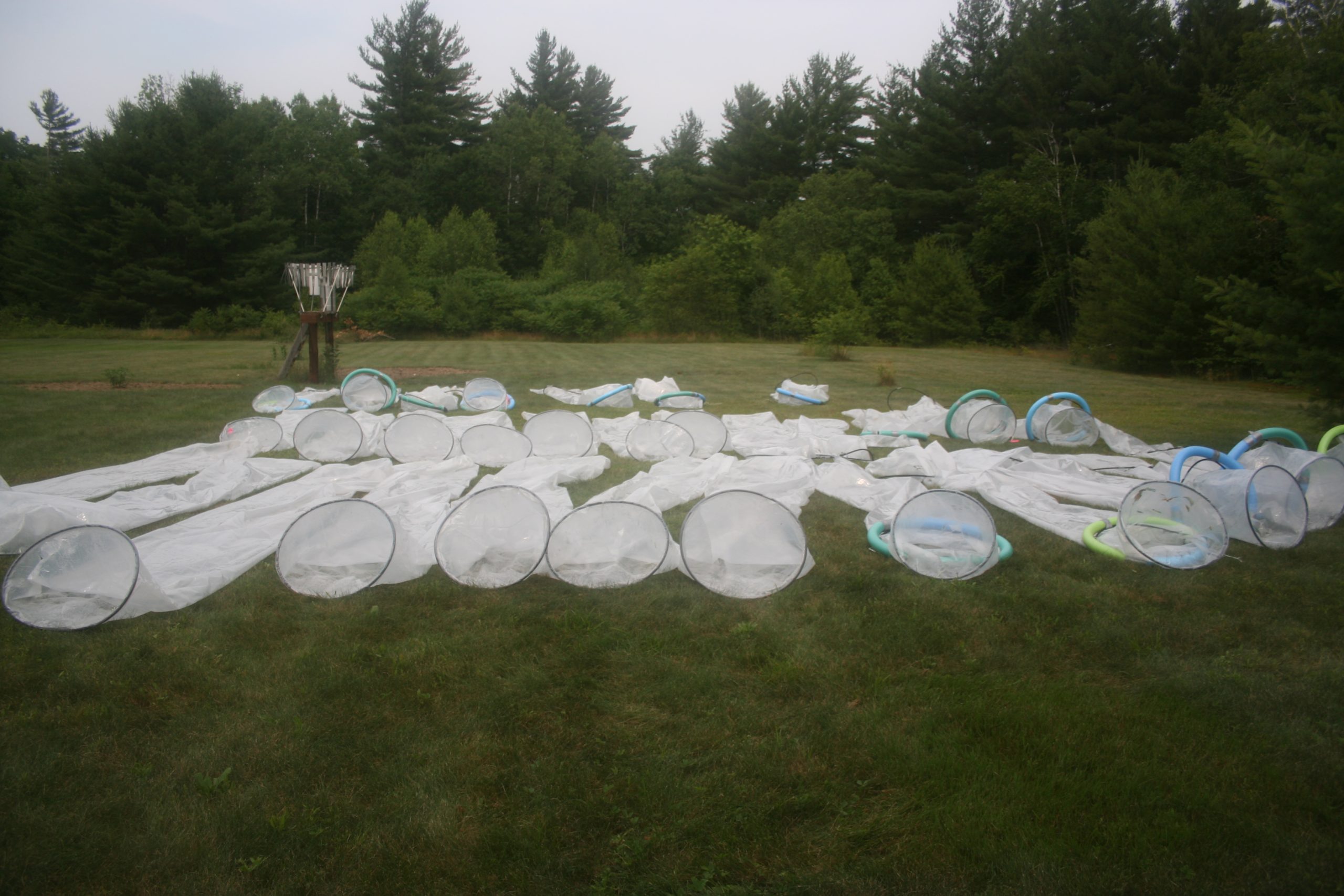
Dave floated these “tunnels” in the lake. Open at the top and bottom, they enclosed a column of water in the lake. In them Dave tested his chemical additions to the lake. They kept the rest of the lake water separate from the experimental water columns. He could measure what happened in each column.
You couldn’t find such an item in any catalog. Dave had to invent the tunnels or columns to do a job that needed doing. Scientists have to be creative, and these monsters looked like something that belonged in Disney World rather than a science laboratory.
A new carryall truck pulled in next to all the other cars in front of the garage. Dr. Likens met the new visitors, who then gathered the porch chairs around a red table and sat down to wait. Introductions were made. Dr. Margaret Davis from the University of Michigan (later at Yale University and the University of Minnesota) had brought her coring team to sample the muddy soils of Mirror Lake’s bottom. Dr. Clyde Goulden from the Academy of Natural Sciences in Philadelphia accompanied the group. He was interested in learning what crustaceans, such as the water flea, had lived at Mirror Lake in the recent and distant past. Dr. Davis offered him all the slices of core he would need to do his studies.
Dr. Likens, Dr. Davis, Dr. Goulden, the coring team, and interested students waited patiently for the drilling specialists that Dr. Likens had hired for Dr. Davis. These specialized drillers were the only commercial group that took scientific cores. A sturdy raft was provided for the corers’ heavy motor, pipes, and rigging. The corers’ truck, loaded with all the necessary equipment, had broken down. A new truck made its way from Pennsylvania to Mirror Lake while everyone waited.
Dr. Likens had extended to Dr. Davis the invitation to core the lake. She seemed calm, as if this type of inconvenience wasn’t new to her. The group agreed that samples of earth from below the bottom of the lake were worth waiting for. Though they all sat calmly chitchatting about experiences on other lakes and the work at the Brook, their suppressed excitement and anticipation charged the air with a new vitality. They were eager to get to work.
Dr. Davis was a paleobotanist, a specialist in identifying pollens from past ages. For centuries pollen from trees and plants had been floating onto the lake, sinking, and being covered by silt, dead plants and animals, and the other debris that fill in a lake bottom. Layers of sediments built up, with the oldest at the bottom and the most recent on the top. When hollow pipes were pushed down through these layers of sediments, they would fill with mud in the same order the sediments were laid down in the lake. The long round tube of dirt inside the pipe would be the core that excited the paleobotanists who studied fossil plants. An apple corer retrieves the core of an apple in a similar way.
Specks of dust – ancient pollens – would tell the trained paleobotanist many things. Pollen grains are like pages from nature’s history book, telling what happened in the past. The amount and kinds of pollen would tell Dr. Davis what plants had grown in the area during past ages. The rainfall, temperature, and other weather conditions needed to grow those plants were known. Once the plants and climate were known, the zoologist, who studied animals, and the entomologist, who studied insects, could deduce what animals had lived in the area long ago.
Next a geologist would look at the rocks, mountains, and valleys and describe present and past landforms. Like a puzzle, a picture of the past would be created from pieces of evidence, bits of fact found in the present.
The thick, round-looking chocolate cookies in plastic bags stored in Pleasant View’s deep freezer were really slices of dirt, samples from other cores. The sections of a core were dated. Scientists knew how many years it took for an inch of sediment to form. They sliced off a piece of years and froze it until they were ready to put it on slides under a microscope to study.
The crew’s excitement was understandable. Had the Hubbard Brook watershed always been a broad-leaved hardwood forest? Had it been a lot colder or warmer or drier or rainier here? Had there ever been glaciers or forests of needled trees like pines or firs? Was the climate gradually changing? Was there a climate pattern? Would a climate period from the past be repeated? They waited with excited suspense eager to find the answers to their questions. Hidden under the Mirror’s waters the answers waited.
While they waited, Penny went out on the lake in her boat. Floating orange balls marked her bottle line. Black and clear bottles were attached at different spots to a long rope that she pulled aboard. Last up was the weight that held the line in place. Penny added some chemicals to each bottle. The clear water turned brown, just like the color in the laboratory samples before Penny added other drops of chemicals that turned the brown water clear.
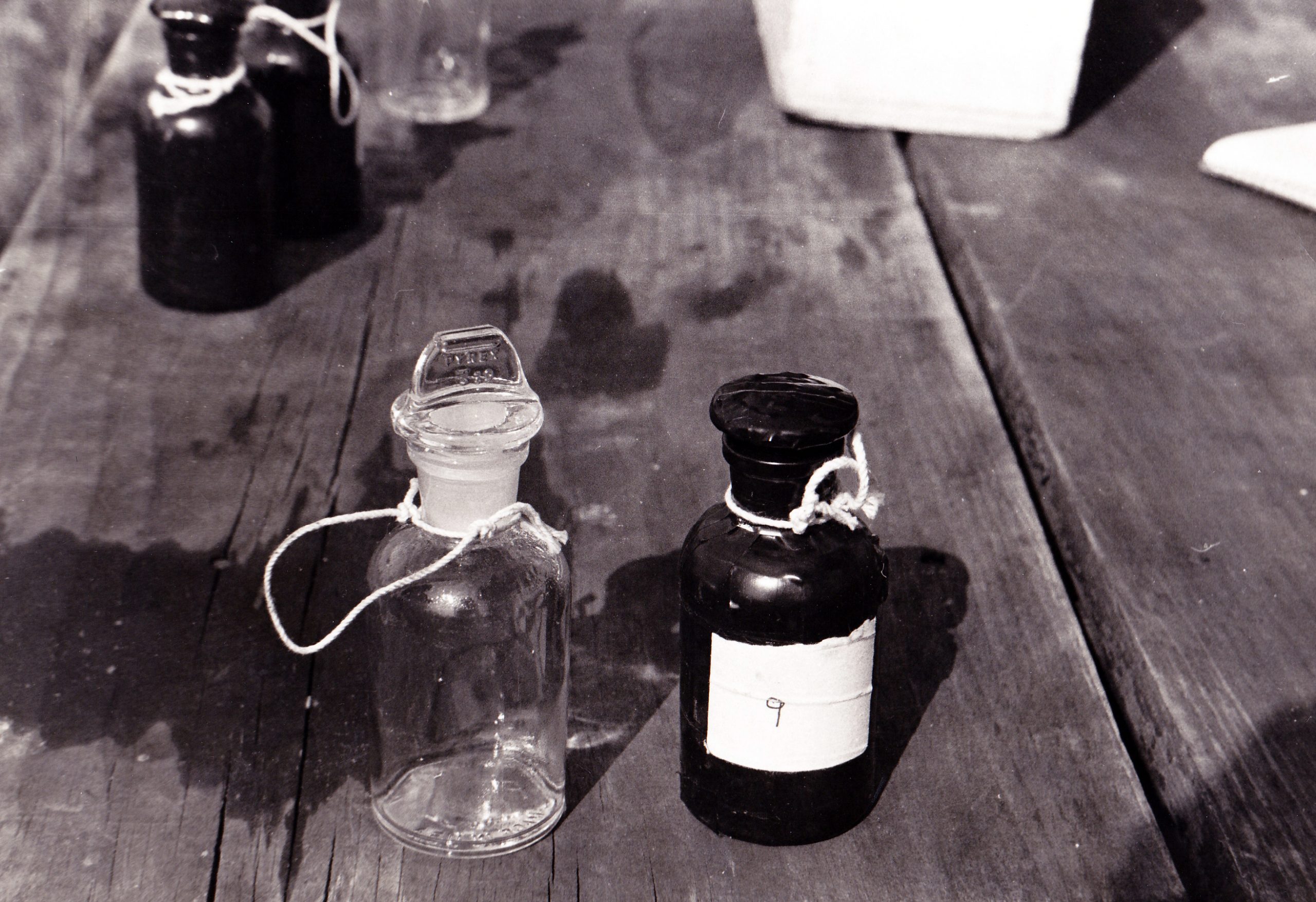
Penny stoppered her two dozen bottles and put each into its own section of a big divided box. She took her samples back to the lab and returned just in time to help row the coring raft into position.
Across the lake floated red-and-white markers that were attached to Dave’s monster cylinders. Dave would find his cylinders easily, collect his water samples, and take them back to his basement lab for analysis.
Suddenly a car appeared and backed a large motorboat into the water. Launched, the boat looked like Gulliver in Lilliput as it started circling the small lake. Waves began hitting a small one-man sailboat, a diving raft, and the swimmers. Then even more unbelievably, the boat backed into shallow water, and the driver’s son grabbed a towrope and began water-skiing. The trees trapped the roaring reverberation of the engine and the waves grew choppier and choppier. The lake was just too small for so much power. Since then, the state of New Hampshire has banned the use of motorboats in the lake.
Luckily the speedboat gave up just before the research crew came. A big truck took a position on shore ten minutes later. The coring and drilling crew was ready to go to work. They must tunnel back into time before dark.
The raft and pipes were very heavy. Everyone worked together lifting them down and floating them. Loaded with pipe, drill, motor, and winch, the raft was roped to three rowboats. Penny, Dave G., and Jim started rowing out to the center of the lake near the north end. Dr. Likens, Dr. Davis, and Dr. Goulden took turns with them at the oars. It wasn’t easy work pulling the heavy raft. Finally in position, it was anchored securely. The coring crew took over. The three men who had brought the raft and equipment set up a derrick that looked like the rigging of a miniature oil well. They placed the rig over a hole in the middle of the raft. Next a big, heavy chain that had been wound around an empty oil drum was pulled through the top of the derrick and hooked to the first section of pipe. A spiral drill was attached to the bottom of the pipe. The brake was released and the chain rolled off the drum as thread unwinds from a spool, lowering the drill and pipe into the water. A vise held the first pipe in the raft’s round hole while the chain was unhooked and attached to a second pipe, which was pulled into position above the first pipe. A driller fitted the second pipe to the first and lowered them both into the lake. And so it went – one section of pipe was fitted to another and lowered into the water.
When the drill hit bottom, the hard work began. The pipes didn’t just slide down as they had. They had to be pushed with all the force the crew could muster into the sediment at the bottom of the lake. Section after section of pipe was pushed through the hole as the drill bore deeper into the sediments, pushing the mud higher into the pipes.
With the last pipe in place, the men paused and rested, hot and tired. Then slowly, carefully, they let the motor wind the chain and pull up the pipes. Section after section was raised, unscrewed, and laid across the raft.
Through the whole operation the scientists again waited. But this time a suppressed joy kept spilling out in jokes and laughter while they rested in the rowboats, feet propped up executive-style.
As the last pipe came up, all the watchers and drilling and coring crews exploded with happy excitement. Even though the oldest, very bottom piece of mud had fallen out, leaving that piece of history hidden, the rest of the cores were good and would keep Dr. Davis busy peering into her microscope for five years. Gradually she would piece her parts of this ecosystem puzzle together and help Dr. Likens reconstruct the area’s natural history.
Near shore a girl was sudsing her hair in the lake. On shore, a family cleaned up after dinner. They dumped their hot coals into the lake and left them there. It had not occurred to them to put their cool coals into the trash can. The lake had many different uses and meaning to many different people.
As the coring observers drove back to Pleasant View, they passed the new highway that sent dust and salt into the lake. A narrow corridor of trees between the lake and the highway had been left to preserve a total woods appearance. Would such a corridor of trees between the lake and the highway preserve the lake?
The lake’s longevity depended on many things. The normal life of a lake can be anywhere from several thousand to a hundred thousand years, depending on where it is and how it is used. Heavily used and badly treated, a little lake like this in New Hampshire could die in fifty to eighty years.
The corridor of trees might help protect the lake. But sometimes a corridor itself dies because the individual trees need the protection of the larger forest from hot sun, winds, insect borers, plant diseases, or rain runoff. Just because a corridor looks like a forest, doesn’t mean it can act like one. That is why there is experimental cutting – to find out whether a good idea for solving conflicts of interest is really workable.
The highway dust might add more silt to the lake, cutting down its algae productivity. The silt could clog up the breathing apparatus of small animals. Dwellings and use could add more fertilizer, greatly increasing the algae productivity. People do not realize their own great power to affect ecosystems. A seemingly permanent, free piece of nature can be easily destroyed. As it turns out, the highway’s main impact on the lake was to increase its salt level.
As the sun set, a starry, dark-blue curtain closed quietly on the day. More acts would follow as scenes unfolded each day at Mirror Lake: swimmers, rowboats and paddle boats, one-person sailboats, children diving from the docks, a raft blowing back and forth across the lake, picnickers, thin teenagers teasing and being chased, babies in playpens, sunning mothers, workmen eating lunch, and researchers gathering data. All would play important roles in the Mirror Lake drama. Mirror Lake would reflect more than faces through the years – it would reflect the care and concern of the people who used it.
The morning after the coring, a medieval scene of dissection took place in Pleasant View’s hallway. On the fifth stair stood the surgeon, Dr. Davis, a scalpel in her plastic-gloved hand. Carefully she cut through a measured muddy glob from the pipe that held a section of sediments from Mirror Lake. In his gloved hand, an assistant held a numbered aluminum pan beneath the glob. The mud slice fell into the pan. He stepped into the dining room, where one of the men waited with his plastic gloves to place the specimen on a glass-enclosed scale. The balance scale measured the wet weight of the specimen to a hundredth of a gram. After drying, the samples would be weighed again, then frozen to preserve them for future study.
Just as you push a stick to get ice cream from a paper cylinder, the coring team used a broomstick and a rubber stopper to push the mud out the top of its tube. Soon the dining table was filled with individual aluminum pie pans each holding a numbered specimen of mud. Five people operated on the cores. As one helper commented, “This isn’t the most interesting work I’ve ever done,” but they all knew it was necessary work.
The group of paleobotanists climbed into their rig with cores not only from Mirror Lake but also from other lakes in the area. They had sampled near the shore and from their own boat and raft with their own smaller equipment. The studies and results of these corings would be reported at scientific meetings and written in scientific journals to become part of general scientific knowledge.
